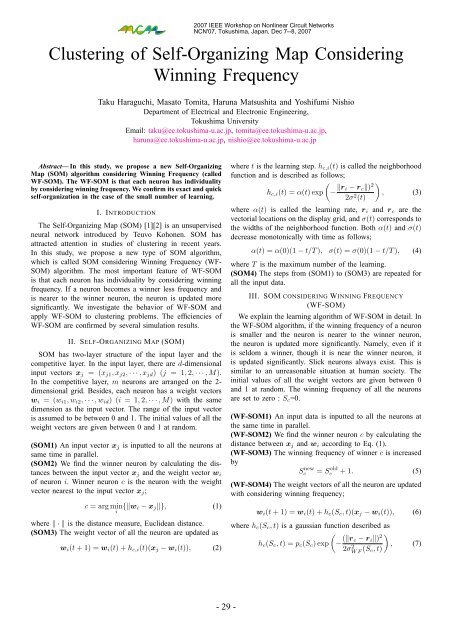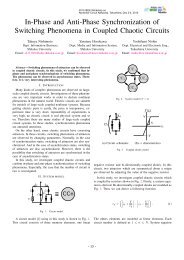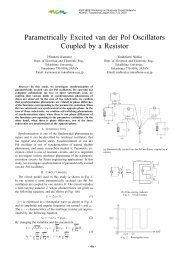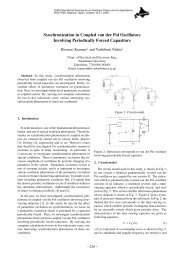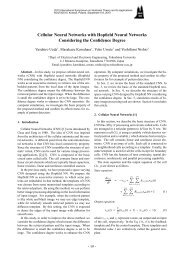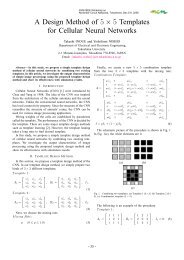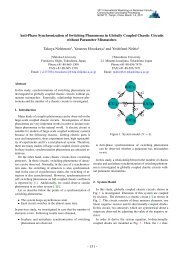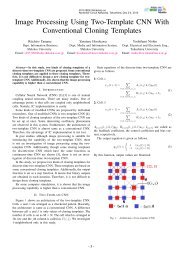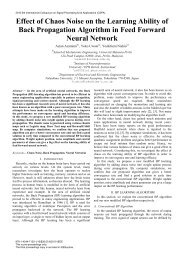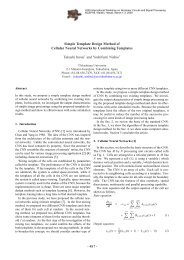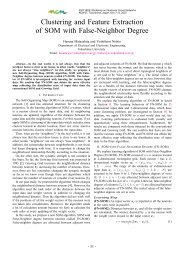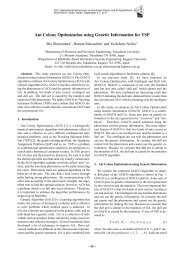Clustering of Self-Organizing Map Considering Winning Frequency
Clustering of Self-Organizing Map Considering Winning Frequency
Clustering of Self-Organizing Map Considering Winning Frequency
You also want an ePaper? Increase the reach of your titles
YUMPU automatically turns print PDFs into web optimized ePapers that Google loves.
2007 IEEE Workshop on Nonlinear Circuit Networks<br />
NCN'07, Tokushima, Japan, Dec 7--8, 2007<br />
<strong>Clustering</strong> <strong>of</strong> <strong>Self</strong>-<strong>Organizing</strong> <strong>Map</strong> <strong>Considering</strong><br />
<strong>Winning</strong> <strong>Frequency</strong><br />
Taku Haraguchi, Masato Tomita, Haruna Matsushita and Yoshifumi Nishio<br />
Department <strong>of</strong> Electrical and Electronic Engineering,<br />
Tokushima University<br />
Email: taku@ee.tokushima-u.ac.jp, tomita@ee.tokushima-u.ac.jp,<br />
haruna@ee.tokushima-u.ac.jp, nishio@ee.tokushima-u.ac.jp<br />
Abstract— In this study, we propose a new <strong>Self</strong>-<strong>Organizing</strong><br />
<strong>Map</strong> (SOM) algorithm considering <strong>Winning</strong> <strong>Frequency</strong> (called<br />
WF-SOM). The WF-SOM is that each neuron has individuality<br />
by considering winning frequency. We confirm its exact and quick<br />
self-organization in the case <strong>of</strong> the small number <strong>of</strong> learning.<br />
I. INTRODUCTION<br />
The <strong>Self</strong>-<strong>Organizing</strong> <strong>Map</strong> (SOM) [1][2] is an unsupervised<br />
neural network introduced by Teuvo Kohonen. SOM has<br />
attracted attention in studies <strong>of</strong> clustering in recent years.<br />
In this study, we propose a new type <strong>of</strong> SOM algorithm,<br />
which is called SOM considering <strong>Winning</strong> <strong>Frequency</strong> (WF-<br />
SOM) algorithm. The most important feature <strong>of</strong> WF-SOM<br />
is that each neuron has individuality by considering winning<br />
frequency. If a neuron becomes a winner less frequency and<br />
is nearer to the winner neuron, the neuron is updated more<br />
significantly. We investigate the behavior <strong>of</strong> WF-SOM and<br />
apply WF-SOM to clustering problems. The efficiencies <strong>of</strong><br />
WF-SOM are confirmed by several simulation results.<br />
II. SELF-ORGANIZING MAP (SOM)<br />
SOM has two-layer structure <strong>of</strong> the input layer and the<br />
competitive layer. In the input layer, there are d-dimensional<br />
input vectors x j = (x j1 , x j2 , · · · , x jd ) (j = 1, 2, · · · , M).<br />
In the competitive layer, m neurons are arranged on the 2-<br />
dimensional grid. Besides, each neuron has a weight vectors<br />
w i = (w i1 , w i2 , · · · , w id ) (i = 1, 2, · · · , M) with the same<br />
dimension as the input vector. The range <strong>of</strong> the input vector<br />
is assumed to be between 0 and 1. The initial values <strong>of</strong> all the<br />
weight vectors are given between 0 and 1 at random.<br />
(SOM1) An input vector x j is inputted to all the neurons at<br />
same time in parallel.<br />
(SOM2) We find the winner neuron by calculating the distances<br />
between the input vector x j and the weight vector w i<br />
<strong>of</strong> neuron i. Winner neuron c is the neuron with the weight<br />
vector nearest to the input vector x j ;<br />
c = arg min<br />
i<br />
{‖w i − x j ‖}, (1)<br />
where ‖ · ‖ is the distance measure, Euclidean distance.<br />
(SOM3) The weight vector <strong>of</strong> all the neuron are updated as<br />
w i (t + 1) = w i (t) + h c,i (t)(x j − w i (t)), (2)<br />
where t is the learning step. h c,i (t) is called the neighborhood<br />
function and is described as follows;<br />
h c,i (t) = α(t) exp<br />
(− ‖r i − r c ‖) 2 )<br />
2σ 2 , (3)<br />
(t)<br />
where α(t) is called the learning rate, r i and r c are the<br />
vectorial locations on the display grid, and σ(t) corresponds to<br />
the widths <strong>of</strong> the neighborhood function. Both α(t) and σ(t)<br />
decrease monotonically with time as follows;<br />
α(t) = α(0)(1 − t/T ), σ(t) = σ(0)(1 − t/T ), (4)<br />
where T is the maximum number <strong>of</strong> the learning.<br />
(SOM4) The steps from (SOM1) to (SOM3) are repeated for<br />
all the input data.<br />
III. SOM CONSIDERING WINNING FREQUENCY<br />
(WF-SOM)<br />
We explain the learning algorithm <strong>of</strong> WF-SOM in detail. In<br />
the WF-SOM algorithm, if the winning frequency <strong>of</strong> a neuron<br />
is smaller and the neuron is nearer to the winner neuron,<br />
the neuron is updated more significantly. Namely, even if it<br />
is seldom a winner, though it is near the winner neuron, it<br />
is updated significantly. Slick neurons always exist. This is<br />
similar to an unreasonable situation at human society. The<br />
initial values <strong>of</strong> all the weight vectors are given between 0<br />
and 1 at random. The winning frequency <strong>of</strong> all the neurons<br />
are set to zero : S c =0.<br />
(WF-SOM1) An input data is inputted to all the neurons at<br />
the same time in parallel.<br />
(WF-SOM2) We find the winner neuron c by calculating the<br />
distance between x j and w i according to Eq. (1).<br />
(WF-SOM3) The winning frequency <strong>of</strong> winner c is increased<br />
by<br />
S new<br />
c<br />
= S old<br />
c + 1. (5)<br />
(WF-SOM4) The weight vectors <strong>of</strong> all the neuron are updated<br />
with considering winning frequency;<br />
w i (t + 1) = w i (t) + h c (S c , t)(x j − w i (t)), (6)<br />
where h c (S c , t) is a gaussian function described as<br />
h c (S c , t) = p c (S c ) exp<br />
(− (‖r c − r i ‖) 2 )<br />
2σW 2 F (S , (7)<br />
c, t)<br />
- 29 -
0 0.1 0.2 0.3 0.4 0.5 0.6 0.7 0.8 0.9 1<br />
1<br />
1<br />
1<br />
0.9<br />
0.9<br />
0.9<br />
0.8<br />
0.8<br />
0.8<br />
0.7<br />
0.7<br />
0.7<br />
0.6<br />
0.6<br />
0.6<br />
0.5<br />
0.5<br />
0.5<br />
0.4<br />
0.4<br />
0.4<br />
0.3<br />
0.3<br />
0.3<br />
0.2<br />
0.2<br />
0.2<br />
0.1<br />
0.1<br />
0.1<br />
0<br />
0<br />
0 0.1 0.2 0.3 0.4 0.5 0.6 0.7 0.8 0.9 1<br />
0<br />
0 0.1 0.2 0.3 0.4 0.5 0.6 0.7 0.8 0.9 1<br />
(a) (b) (c)<br />
Fig. 1.<br />
Learning Simulation. (a) Input data. (b) Simulation result <strong>of</strong> conventional SOM. (c) Simulation result <strong>of</strong> WF-SOM.<br />
where p c (S c ) is described as<br />
p c (S c ) = α W F (S c ) exp<br />
(<br />
− S )<br />
c<br />
, (8)<br />
M<br />
where α(S c ) is the learning rate, and σ(S c , t) corresponds to<br />
the width <strong>of</strong> the neighborhood function. α(S c ) decrease with<br />
the number <strong>of</strong> being winner as follows and σ(S c , t) decrease<br />
with time and the number <strong>of</strong> being winner as follows;<br />
α W F (S c ) = α W F (0) S c<br />
M ,<br />
σ W F (S c , t) = σ W F (0) S c<br />
t , (9)<br />
If the winning frequency <strong>of</strong> a neuron is smaller and the neuron<br />
is nearer to the winner neuron, the neuron is significantly<br />
updated.<br />
(WF-SOM5) The steps from (WF-SOM1) to (WF-SOM4) are<br />
repeated for all the input data.<br />
IV. LEARNING SIMULATION<br />
Input data is 2-dimensional random data <strong>of</strong> 1000 points<br />
whose distribution is non-uniform as Fig.1(a). We repeat the<br />
learning 3 times for all the input data. This is smaller than<br />
the general simulation as the learning times. We consider the<br />
conventional SOM and the proposed WF-SOM with M=100<br />
neurons (10 × 10). The parameters <strong>of</strong> the learning are chosen<br />
as follows;<br />
(For SOM)<br />
(For WF-SOM)<br />
α(0) = 0.9, σ(0) = 3, (10)<br />
α W F (0) = 0.9, σ W F (0) = M/3, (11)<br />
Figures 1(b) and (c) show the learning results <strong>of</strong> the conventional<br />
SOM and WF-SOM, respectively. We can see that the<br />
conventional SOM does not self-organize all the corners <strong>of</strong> the<br />
input in the case <strong>of</strong> the small number <strong>of</strong> learning. On the other<br />
hand, WF-SOM can self-organize all the corners <strong>of</strong> the input<br />
although the number <strong>of</strong> learning is small. From these figures,<br />
we can say that WF-SOM can self-organize more exactly and<br />
quickly than the conventional SOM. However, WF-SOM tends<br />
to produce twists between the neurons.<br />
In order to evaluate the mapping precision <strong>of</strong> WF-SOM, we<br />
define a quantization error e q [2].<br />
Quantization Error e q : This measures the average distance<br />
between each input vector and its winner;<br />
e q = 1 N∑<br />
‖x j − ¯w j ‖, (12)<br />
N<br />
j=1<br />
where ¯w j is the weight vector <strong>of</strong> the corresponding winner<br />
<strong>of</strong> the input vector x j . Therefore, the small value e q is more<br />
desirable. If the weight vector <strong>of</strong> the winner neuron is exactly<br />
the same as input data, the value <strong>of</strong> e q is 0.<br />
The calculated results are summarized in Table 1. We can<br />
evaluate the effectiveness <strong>of</strong> the method using WF-SOM.<br />
Furthermore, the improvement rate is 12.3 [%].<br />
TABLE I<br />
QUANTIZATION ERROR FOR 2-DIMENSIONAL INPUT DATA.<br />
Conventional SOM WF-SOM<br />
e q 0.0244 0.0214<br />
V. CONCLUSIONS<br />
In this study, we have proposed WF-SOM. We have explained<br />
the differences between SOM and WF-SOM with<br />
learning algorithm and have investigated its behavior. Furthermore,<br />
we have applied the proposed WF-SOM to clustering<br />
problems in the case <strong>of</strong> the small number <strong>of</strong> learning and have<br />
confirmed its exact and quick self-organization.<br />
In the future, we try to reduce the twists between neurons.<br />
ACKNOWLEDGMENT<br />
This work was partly supported by Yamaha Music Foundation.<br />
REFERENCES<br />
[1] T. Kohonen, “The <strong>Self</strong>-<strong>Organizing</strong> <strong>Map</strong>s,” Neurocomputing, vol. 21,<br />
pp. 1-6, 1998.<br />
[2] T. Kohonen, <strong>Self</strong>-<strong>Organizing</strong> <strong>Map</strong>s, Berlin, Springer, vol. 30, 1995.<br />
- 30 -


